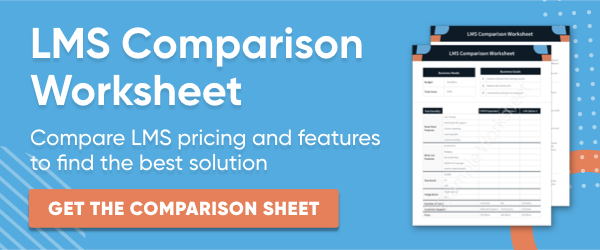It’s widely accepted by company leaders that training is a worthwhile and necessary investment. This is because many statistics prove the importance of staff training. For example, companies that offer comprehensive employee training programs have 218 percent higher income per employee than organizations that don’t and experience a 24 percent higher profit margin, according to ATD.¹
That information is harder to come by. You need to not only determine your business goals and KPIs, you may also need to combine data from multiple sources, such as customer surveys, your CRM, and your learning management system (LMS), to paint a complete picture. But it can be done. By using LMS reporting to measure and contextualize different types of data, L&D professionals can prove the business value of employee training programs.

3 Tips for Assessing the Value of Employee Training Programs Using LMS Reports
LMS reports can give your company insight into whether or not a training program is paying off, and to what extent. Here are a few ways you can use LMS reporting and analytics to assess the value of your company’s staff training courses and programs:
1. Measure customer satisfaction rates -- Customer satisfaction has a lot to do with the business value of a training program. Effectively trained staff are often better equipped to represent their company’s brand well. When staff are truly being the face of the company, customers are happier and more loyal to the brand. According to a contributor to Northpass,
“Customer satisfaction is an early indicator of loyalty and increased customer lifetime value (CLV or LTV). So one great way to demonstrate ROI of your training program is to look at your customer satisfaction scores and at the number of positive reviews before employees start engaging with training and to watch how those scores improve.”²
Technology companies, associations, and other organizations can use extended enterprise LMS reporting tools to send out surveys that gauge customer satisfaction. Companies can combine that information with data from their CRM or other collection methods, such as a CSAT, to determine satisfaction rates. For the most accurate results, organizations should benchmark satisfaction before and after training is implemented. Data should also be collected over a period of several years as increasing numbers of employees receive higher levels of training so you can report on how satisfaction is changing over time.
Present customer satisfaction data alongside training information. What was customer satisfaction levels before training? Did they improve after you implemented employee training, such as customer service training for your front-line representatives? Providing contextualized data will connect training to key business metrics.
2. Measure operational efficiency -- A result of an impactful training program is a more skilled workforce but while measuring the competencies of individual employees is common, it isn’t the only way to verify the efficacy of training. Because overall operational efficiency increases when workers become more skilled, measuring operational efficiency with learning management system reports can also give L&D professionals the information they need to prove the business value of a training program.
Measure your organization’s operational efficiency by using LMS reporting and analytics features to track data such as time taken to onboard new hires and time to productivity. As you shorten your onboarding timeline and time to productivity, you’ll greatly increase operational efficiency and help make your business more profitable. If this data is measured before and after the implementation of a training program, it is easier to prove the business value of that program.
3. Measure skills gaps -- L&D professionals should understand where skills gaps exist within a workforce. This not only assists them in creating better training content, it also shows them which skills are being successfully retained by employees and can help them prove the business value of the training programs and courses that targeted those skills.
According to Training Industry, half of all learning and development programs are wasted because “employees don’t apply what they’ve learned on the job. These roadblocks create serious challenges to learning and development professionals who must not only ensure that their training works but prove it as well.”³
By measuring skills gaps before and after the launch of a training program, L&D professionals can get a better idea of the value of that program. To measure a skills gap using an LMS, administrators can send out and track assessments before, within, and at the end of courses, in addition to periodically checking in with learners. If the training program is in a blended learning format, instructors or managers could provide in-person demonstrations and review of skills once courses are completed.
Related Reading: 3 Signs an LMS Lacks the Right Reporting Tools
How Does Your Company Prove the Business Value of Training?
LMS reporting can help L&D professionals creatively prove the business value of a training program by measuring data that provides insight into customer satisfaction, operational efficiency, and skills retention. This gives them the feedback needed to improve training and the overall learner experience.
Is your company using LMS reports to assess the value of training? Download the LMS Comparison Tool to assess what tools your organization needs to find in an LMS.
References:
1. Shift eLearning. Mind-blowing statistics that prove the value of employee training and development. https://www.shiftelearning.com/blog/statistics-value-of-employee-training-and-development.
2. Northpass. How to prove the ROI of your training program. https://www.northpass.com/blog/how-to-prove-the-roi-return-on-investment-of-your-online-training-program.
3. Training Industry. How to show the business value of training and learning in 10 simple steps. https://trainingindustry.com/articles/measurement-and-analytics/how-to-show-the-business-value-of-training-and-learning-in-10-simple-steps/.






